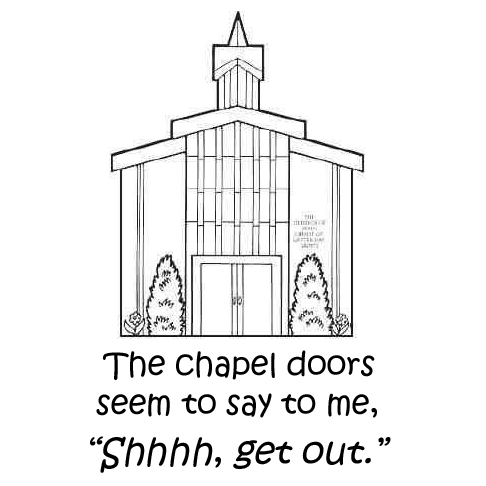In the April General Conference, President Rosemary Wixom shared the story of a young mother who had left the Church. The woman did so not “because of bad behavior, spiritual apathy, looking for an excuse not to live the commandments, or searching for an easy out” but as part of her lifelong search for truth. That search was something she had learned at home, in Primary, in Young Women, and in seminary. She left because she was teachable and was not finding answers within the Church. Only after finding a separate space for herself was she able to further develop her faith in the Savior and testimony of basic gospel truths.[1]
Like this woman and many of our peers, my wife has chosen to leave the Church in her quest to develop a closer relationship with the Savior and to learn what she really believes.
For her family and many other church members we know, this decision is a cause for mourning. As word spread in the ward that I still attend, I began to receive consoling comments from those around me. When she occasionally attended a meeting or activity, she was greeted with meaningful hugs from members she hardly knew. (Which, by the way, did not make occasional attendance any more appealing.)
This sense of mourning is a perfectly natural reaction if we focus exclusively on that single change: she did attend church and now she doesn’t. That’s a neatly wrapped narrative of fall. But like the original Fall, what has really taken place is more complex and positive than it might initially appear. There is plenty of reason to rejoice.[2]
Like the young mother in Pres. Wixom’s talk, my wife struggled for years over what she believed and where she fit in the Church. Diligent study, attendance, and serving in callings did not solve this struggle. Though we had close friends in our wards, she rarely found attendance to be uplifting or inspiring. Instead, her questions mounted alongside frustration with those who were intolerant of the ideas or struggles of others. The Church was decidedly not leading her to Christ or bringing peace into her life.
Faced with this continuing frustration, my wife chose to prioritize her testimony of the Savior over her participation in the Church. As with any act of true discipleship, this decision wasn’t easy. But it was absolutely the right decision, one that has blessed her and our family.
It was the right decision because it was an active decision to follow the Savior. She chose to be a “thing to act” in developing her testimony instead of a “thing to be acted upon” by the Church, to use Lehi’s language.[3] After years of wrestling to build her testimony of the Savior in spite of the discomfort she felt within the Church, my wife is now acting with greater courage and effort than were required of her within the Church. And with that courage and effort come positive, Christlike growth.
It was the right decision because her new church encourages her to seek Christ. There, my wife can more easily connect with the Savior because she is comfortable being herself. She is welcomed for who she is while simultaneously being encouraged and supported in her spiritual growth. She is invited to do meaningful service for strangers in need with much greater frequency. She finds peace and a sense of worship that was lacking for her in the LDS Church. There’s a far greater focus on living as Christ would have us live – literally following the example of His life – than making sure she doesn’t violate a set of standards. That’s both inspiring and fulfilling.
It is true that this change arose from a struggle with doubt and uncertainty. But that struggle existed even while my wife was active and dedicated to the Church. That her struggle is now public knowledge is a sign not of crisis but of progress. She made a difficult decision to seek after the Savior, despite the pressures around her. That is something we should be ready to celebrate.
Has her search led her to the same certainties proclaimed by me or other believing Latter-day Saints? No. But her aim is right and I have faith that Christ is guiding her now more than ever. She’s been led to good people as part of that journey and I am grateful for what they have given her.
The woman in Pres. Wixom’s story described the state of her testimony when she left the Church in these words, “My testimony had become like a pile of ashes. It had all burned down. All that remained was Jesus Christ.” Unfortunately, In the Church, we don’t make this level of belief very easy.
Though we proclaim faith in Christ as the first principle of the gospel, in practice we often demand that members start with Joseph Smith and the Book of Mormon, building outwardly from there to accept all of our peculiar doctrines. Members with doubts about these doctrines receive powerful signals from fellow members to quiet their questions, accept the testimony of others, and keep their spiritual journey to themselves. We celebrate those who return but are rarely willing to put aside our formulaic work on Church programs to administer to those in the midst of these transitions.
What would our wards and stakes be like if we instead lived this counsel from President Dieter F. Uchtdorf?
“In the end, we are all pilgrims seeking God’s light as we journey on the path of discipleship. We do not condemn others for the amount of light they may or may not have; rather, we nourish and encourage all light until it grows clear, bright, and true.”[5]
That is what we’re doing now, in our own family. We attend different churches and worship in different ways, but “we talk of Christ, we rejoice in Christ, we preach of Christ, [and] we prophesy of Christ” with greater frequency, openness, enthusiasm, and meaning than we did before.[6] Together, the Light of Christ in our lives is growing clearer, brighter, and truer. I hope other members can join us in rejoicing with those who make difficult decisions to follow the Savior, even if discipleship takes them on a journey outside of our church.
[1] Pres. Rosemary Wixom, “Returning to Faith,” April 2015 Gen. Conf.
[2] See, for instance, Eve’s rejoicing in Moses 5:11
[5] Pres. Uchtdorf, “Receiving a Testimony of Light and Truth,” Oct. 2014 Gen. Conf.





Thanks for this post Jason. The church taught me a love for seeking truth. As I’ve looked outside the church, using the same patterns I learned about truth seeking growing up in the church, I’ve been enriched spiritually. The “fullness of the gospel” restored through Joseph Smith wasn’t full without the yet revealed “many great and important things” that he spoke of in the 9th article of faith.
What keeps us from learning “many great and important things” is the inertia of the “safety” and “protection” of the church. Thanks be to a loving Father in Heaven for the faith crises of your wife, of my wife and of many others. By these crises, we have been blessed with the courage to look outside the safety and protection of the church and to be enriched, not by a power promising covenental relationship with God, but by a vulnerable relationship with God, modeled by Jesus. This vulnerability focuses us not on our own salvation, but on those whom Jesus focused his efforts on.
Thanks again for sharing your story Jason. I rejoice with you and your family as we tread similar paths!!
Jeffrey,
Thank you for your comments. I’m glad you enjoyed the post.
Thanks for sharing this, Jason. I really like that you and your wife respect each other’s decisions and journeys and focus on the things you’re working on in common. I wish this type of story could be in official church discourse more often, rather than only having stories where people come back to full activity in the Church.
I’m curious as to which church your wife is attending. I understand that for the context of this story it is not important, but I am searching for the same fulfillment in Christ that it seems your wife is now getting. Thanks!
Lindsay,
She attends a UCC congregation in the area, with a special small group outreach program. It’s been a great spiritual home for her and a wonderful bunch of people for us to get to know.
Hi Jason! Andy shared your post with me and it reminded me of how much we already feel your family’s loss at (a)Spire! I have always had much admiration for the two of you and how you share and teach your faith with your *sweet son!* He will grow up knowing that he is a beloved Child of God wherever he worships and wherever he lives! Sending our love and blessings to you in all of your future endeavors!
Wow! This is my story, too. So many believe that it isn’t possible to be happy and find personal spiritual fulfillment outside of the church, but you sure can. So many think a mixed faith LDS marriage can’t work, but it can, beautifully. Thank you for writing this. Our spouses are so courageous for walking this path, and like you I have witnessed so many blessings.
Beautiful. Thank you for sharing this.
Allison,
Thank you so much. We’re certainly going to miss (a)Spire and the community we’ve found there.
Jess,
I’m glad to find others who are also walking this path and finding it brings blessings. One of the things I’ve liked about my wife’s new church community is absolutely-not-a-big-deal it was that we attended different churches. I wish the LDS Church was better at embracing that.
Your wife sounds much like me. I’m on my own journey of faith and striving to have a more Christ-centric life. I want to know more of Him and less of the prophets. Thank you for your post. It reminds me we are never alone.
Jason, I really enjoyed your post! My faith journey has taken me outside the LDS church, much like your wife. I shared your blog post on my FB page and my nephew (who is LDS) said that he thought you misrepresented Sister Wixom’s talk by saying that she said it was okay to leave the church. I do agree with him. I don’t think that was the point of her talk. I went and read the talk, and the young mother never left the church, as you summarized–but only became less active as she searched for what she truly believed in. It mentioned how supportive her family, bishop, and members of her ward were at that time. It then talked about how she used the primary songs, scriptures and basic gospel principles to build her faith back and how she accepted a calling as Primary Pianist and regained her faith. I think the thing that resonated to me in the talk was the support and love that was given from the young woman’s family, bishop and ward members through her faith crisis. Even though she did stay in the church, there are some that may not take that same path, and may not find happiness within the church–like your wife or myself. Everyone is on their own spiritual journey.
Shandra,
The never-alone-ness has been an important lesson for us in this transition, so I’m glad I could share it with you.
Sharon,
I’m glad you enjoyed the post.
As far as Sis. Wixom’s talk, I think our difference in reading is mostly about what timing we emphasize and what we mean by “left the Church.” You’re right that Pres. Wixom told the story to emphasize the return journey, something we often celebrate. She mentioned support from family, ward members, and the bishop as well as the strength she drew from Primary and Primary materials.
But I was struck by the way Pres. Wixom also emphasized that it was righteous qualities that led her search. Despite this and despite the support she received, she eventually stopped attending the LDS Church. It’s that part of the story, from active to inactive, that most intrigued me. Had someone asked about the woman at that point in her story – when she was no longer attending and her testimony was like ashes – people may have also felt she had left the church. And it was a non-LDS source (writings of Mother Teresa) that helped her in that time.
Right now, that’s where my wife is. She hasn’t given up her membership. But she’s not attending, doesn’t have plans to attend, and is drawing a great deal of strength from non-LDS sources (more than she was drawing from within the Church). I don’t assume she’ll “return,” but if she did, it would be easy to tell the story like Sis. Wixom does. I just don’t think that right now “inactive” is a very good description for a very active, positive faith journey. It only really works in retrospect. I suspect the same was true of the woman in Pres. Wixom’s talk, but I recognize that’s reading between the lines.
Thanks for your wonderful comment and the chance to elaborate a bit. I wish you well in your own spiritual journey and hope you’re finding support from family and others.
Adam and Others helped in creation, it is true that Adam helped to form this earth. He labored with our Savior Jesus Christ. I have a strong view or conviction that there were others also who assisted them. Perhaps Noah and Enoch; and why not Joseph Smith. Doctrines of Salvation Vol. 1 p 74-75
The Bible says God did the creation alone ?
Isa. 44:24
Thus says the LORD, your Redeemer,
And He who formed you from the womb:
“I am the LORD, who makes all things,
Who stretches out the heavens all alone,
Who spreads abroad the earth by Myself;